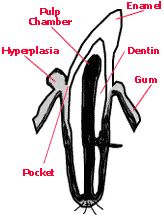Dental Resorptive Lesions
Cats are prone to a serious dental disease called 'external odontoclastic resorption lesions' (EORLs), 'cervical line lesions', or 'neck lesions'.
 This is the most common disease in feline dentistry. Various studies have found 28-67 per cent of cats have resorptive lesions. They are the most common cause of tooth loss in the cat. EORLs tend to occur in older cats (over 4 years of age) and may be more common in purebred cats, especially Siamese and Abyssinians.
This is the most common disease in feline dentistry. Various studies have found 28-67 per cent of cats have resorptive lesions. They are the most common cause of tooth loss in the cat. EORLs tend to occur in older cats (over 4 years of age) and may be more common in purebred cats, especially Siamese and Abyssinians.
What are dental resorption lesions?
Dental resorption lesions result in the loss of tooth structure, starting with the outer enamel surface, usually at or below the gum line. The lesions, which are NOT cavities, begin as a loss of tooth enamel and can eventually spread to the dentin and then the pulp canal, which contains the blood vessels and nerves to the tooth. Sometimes the entire crown of the tooth may be missing.
Resorptive lesions are progressive and may be singular or multiple and on the lingual (side where the tongue is) or buccal (side where the cheek is) side of the tooth. Some lesions are readily apparent and others may be hidden under areas of plaque or swollen gums. This is why a cat needs to be anesthetized to determine if such lesions are present: the entire surface of each tooth must be examined.
The lesions most commonly occur in the larger, multi-rooted teeth - the molars and premolars - at the area where the roots diverge. They can also occur in the canine teeth and incisors.
What causes dental resorption lesions?
The cause of these resorption lesions is unknown. One theory is that the inflammation caused by plaque may stimulate cells called 'odontoclasts' which eat away at the enamel of the tooth. Other possible causes include autoimmune disorders, viral diseases or a nutritional deficiency. A more recent theory says that hard cat food may play a role in the formation of resportive lesions. Since cat teeth are made for tearing and biting, using them for grinding hard foods may lead to these lesions.
What signs of disease are associated with resorption lesions?
EORLS which have eroded through the enamel may be very painful. Cats with oral pain may appear irritable or aggressive, have a change in appetite or food preference and may have difficulty chewing and eating (food falls from their mouth). Cats with EORLs may show pain when their jaws are touched and may also have increased salivation or oral bleeding.
How are resorption lesions diagnosed?
Many lesions may be easily visible. However a dental explorer should be used to examine each tooth above and below the surface of the gum. Any calculus on the teeth needs to be removed before a complete examination can be performed.
Dental radiographs are helpful in diagnosing this condition and evaluating the extent of disease.
How are resorption lesions treated?
In general, teeth with EORLs are extracted. This removes the source of pain and discomfort for the pet. If the EORL has destroyed a large portion of the tooth, it may break off, leaving the root behind. In these cases the root may need to be removed.
It is recommended that cats who have a history of EORLs should have a prophylaxis (professional dental cleaning) every six months.
Cookies on this website are used to both support the function and performance of the site, and also for marketing purposes, including personalizing content and tailoring advertising to your interests. To manage marketing cookies on this website, please select the button that indicates your preferences. More information can be found in our privacy policy here.
We've upgraded our online store!
Ordering your pet's favorite food and medicine is now easier than ever.
Order Food & Meds
Quick & Easy Registration

Please use the phone number and email you currently use for hospital communications to link your account!
Linked Pet Records & Rx

Your pet's prescriptions and records will be waiting for you!
Pawsome
Savings!

AutoShip discounts, promotions on your favorite products and more!


